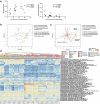Continuous pre- and post-transplant exposure to a disease-associated gut microbiome promotes hyper-acute graft-versus-host disease in wild-type mice
- PMID: 31928131
- PMCID: PMC7524395
- DOI: 10.1080/19490976.2019.1705729
Continuous pre- and post-transplant exposure to a disease-associated gut microbiome promotes hyper-acute graft-versus-host disease in wild-type mice
Erratum in
-
Correction.Gut Microbes. 2020 Jul 3;11(4):1131-1133. doi: 10.1080/19490976.2020.1736066. Epub 2020 Feb 27. Gut Microbes. 2020. PMID: 32106763 Free PMC article. No abstract available.
Abstract
Objective: The gut microbiome plays a key role in the development of acute graft-versus-host disease (GVHD) following allogeneic hematopoietic stem cell transplantation. Here we investigate the individual contribution of the pre- and post-transplant gut microbiome to acute GVHD using a well-studied mouse model.
Design: Wild-type mice were cohoused with IL-17RA-/ - mice, susceptible to hyperacute GVHD, either pre- or post-transplant alone or continuously (i.e., pre- and post-transplant). Fecal samples were collected from both WT and IL-17RA-/ - mice pre- and post-cohousing and post-transplant and the microbiome analyzed using metagenomic sequencing.
Results: Priming wild-type mice via cohousing pre-transplant only is insufficient to accelerate GVHD, however, accelerated disease is observed in WT mice cohoused post-transplant only. When mice are cohoused continuously, the effect of priming and exacerbation is additive, resulting in a greater acceleration of disease in WT mice beyond that seen with cohousing post-transplant only. Metagenomic analysis of the microbiome revealed pre-transplant cohousing is associated with the transfer of specific species within two as-yet-uncultured genera of the bacterial family Muribaculaceae; CAG-485 and CAG-873. Post-transplant, we observed GVHD-associated blooms of Enterobacteriaceae members Escherichia coli and Enterobacter hormaechei subsp. steigerwaltii, and hyperacute GVHD gut microbiome distinct from that associated with delayed-onset disease (>10 days post-transplant).
Conclusion: These results clarify the importance of the peri-transplant microbiome in the susceptibility to acute GVHD post-transplant and demonstrate the species-specific nature of this association.
Keywords: Enterobacteriaceae; GVHD; Muribaculaceae; S24-7; cohousing; hematopoietic stem cell transplant; microbiome.
Figures




Similar articles
-
Acute graft-versus-host disease is regulated by an IL-17-sensitive microbiome.Blood. 2017 Apr 13;129(15):2172-2185. doi: 10.1182/blood-2016-08-732628. Epub 2017 Jan 30. Blood. 2017. PMID: 28137828 Free PMC article.
-
Metagenomic analysis of the stool microbiome in patients receiving allogeneic stem cell transplantation: loss of diversity is associated with use of systemic antibiotics and more pronounced in gastrointestinal graft-versus-host disease.Biol Blood Marrow Transplant. 2014 May;20(5):640-5. doi: 10.1016/j.bbmt.2014.01.030. Epub 2014 Jan 31. Biol Blood Marrow Transplant. 2014. PMID: 24492144 Free PMC article.
-
Microbiome and diversity indices during blood stem cells transplantation - new perspectives?Cent Eur J Public Health. 2019 Dec;27(4):335-339. doi: 10.21101/cejph.a5393. Cent Eur J Public Health. 2019. PMID: 31951695
-
Allogeneic hematopoietic cell transplantation, the microbiome, and graft-versus-host disease.Gut Microbes. 2023 Jan-Dec;15(1):2178805. doi: 10.1080/19490976.2023.2178805. Gut Microbes. 2023. PMID: 36794370 Free PMC article. Review.
-
Microbiome: An Emerging New Frontier in Graft-Versus-Host Disease.Dig Dis Sci. 2019 Mar;64(3):669-677. doi: 10.1007/s10620-018-5369-9. Epub 2018 Dec 7. Dig Dis Sci. 2019. PMID: 30523482 Review.
Cited by
-
Polygonatum cyrtonema polysaccharides reshape the gut microbiota to ameliorate dextran sodium sulfate-induced ulcerative colitis in mice.Front Pharmacol. 2024 Jun 5;15:1424328. doi: 10.3389/fphar.2024.1424328. eCollection 2024. Front Pharmacol. 2024. PMID: 38898924 Free PMC article.
-
Impact of weight variation on the microbiome of yak dams and calves.Front Microbiol. 2024 Sep 18;15:1465992. doi: 10.3389/fmicb.2024.1465992. eCollection 2024. Front Microbiol. 2024. PMID: 39360324 Free PMC article.
-
Crosstalk Between Intestinal Microbiota Derived Metabolites and Tissues in Allogeneic Hematopoietic Cell Transplantation.Front Immunol. 2021 Aug 27;12:703298. doi: 10.3389/fimmu.2021.703298. eCollection 2021. Front Immunol. 2021. PMID: 34512627 Free PMC article. Review.
-
Links between fecal microbiota and the response to vaccination against influenza A virus in pigs.NPJ Vaccines. 2021 Jul 22;6(1):92. doi: 10.1038/s41541-021-00351-2. NPJ Vaccines. 2021. PMID: 34294732 Free PMC article.
-
Human mesenchymal stem cells treatment improved hepatic lesions and reversed gut microbiome disorder in non-alcoholic steatohepatitis.Aging (Albany NY). 2020 Nov 8;12(21):21660-21673. doi: 10.18632/aging.103962. Epub 2020 Nov 8. Aging (Albany NY). 2020. PMID: 33168782 Free PMC article.
References
-
- Castilla-Llorente C, Martin PJ, McDonald GB, Storer BE, Appelbaum FR, Deeg HJ, Mielcarek M, Shulman H, Storb R, Nash RA. Prognostic factors and outcomes of severe gastrointestinal GVHD after allogeneic hematopoietic cell transplantation. Bone Marrow Transplant. 2014;49:966. doi:10.1038/bmt.2014.69. - DOI - PMC - PubMed
Publication types
MeSH terms
Substances
LinkOut - more resources
Full Text Sources
